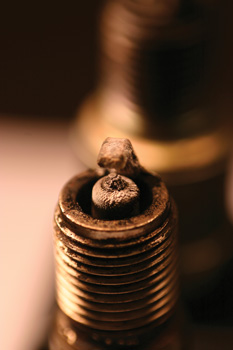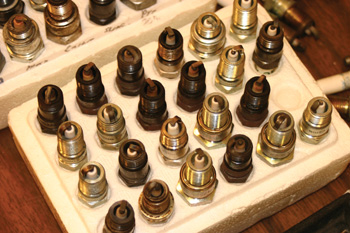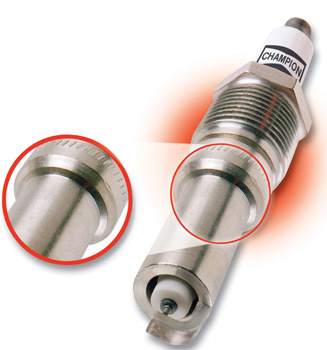 Minimizing Engine Misfires
Minimizing Engine Misfires
Plug wires are vulnerable to heat and vibration damage, and can become a source of ignition misfire if they become wet. Boots can loosen up as a result of mishandling (jerking on the plug wires), or become brittle and hard with age. Carbon tracks can also form inside the boots allowing arcing and misfires to occur.
The insulation around old plug wires can break down and leak voltage, also causing the engine to misfire. In older carbon-core wire sets, the resistance of the conductor inside the cable can change as a result of heat and vibration, creating yet another source for misfires. So changing the ignition system to a coil-on-plug setup with no high voltage plug wires reduces the risk for misfires.
Most late-model original equipment spark plug wire sets now use spiral-wound stainless steel mag wire. This type of construction uses less internal resistance than carbon-core wires (only about 500 ohms/foot vs. 5,000 ohms/foot with carbon-core wire). It uses inductance rather than resistance to suppress radio frequency interference (RFI). The result is a hotter spark with less voltage load on the ignition system.
Misfires are a huge no-no in vehicles that have to meet today’s low emissions requirements. The OBD II misfire monitor can detect misfires that years ago nobody would have paid much attention to because they didn’t seem to be much of a problem. But today it’s a different story. Catalytic converters are expected to last more than 100,000 miles, which means they can’t tolerate many misfires. And if the Check Engine light is on and misfire codes (or any other codes) are present, the vehicle won’t pass an OBD II plug-in emissions test.
My, How You’ve Changed
Up until the mid-1970s, the average life of a spark plug was only about 12,000 to 15,000 miles. Tetraethyl lead in gasoline was a great octane-boosting additive, but it also caused plugs to foul rather quickly. And once the plug fouled, it would misfire. Thus, the annual tune-up was a necessity for most drivers.
 When catalytic converters became standard in 1975 to reduce tailpipe emissions, lead was eliminated as a gasoline additive. The result was a dramatic increase in spark plug life. Most plugs would last up to 45,000 miles on unleaded gasoline. Fouling could still occur as a result of oil burning, extended idling or short trip, stop-and-go driving, but electrode wear became the limiting factor on how long the plugs would last before they had to be changed.
When catalytic converters became standard in 1975 to reduce tailpipe emissions, lead was eliminated as a gasoline additive. The result was a dramatic increase in spark plug life. Most plugs would last up to 45,000 miles on unleaded gasoline. Fouling could still occur as a result of oil burning, extended idling or short trip, stop-and-go driving, but electrode wear became the limiting factor on how long the plugs would last before they had to be changed.
Every time a spark plug fires, the spark burns a few molecules of metal off the plug’s electrodes. Over time, this eats away the electrodes and rounds off their sharp edges. The erosion gradually increases the gap between the electrodes, which in turn, increases the firing voltage required to generate a spark. Eventually the point is reached where the ignition system fails to produce enough voltage and the plug misfires.
Misfires are bad news because they cause a noticeable loss of power and fuel economy, and a less obvious, but very measurable, increase in unburned hydrocarbon (HC) emissions. The catalytic converter can take care of the extra HC up to a point, but a steady misfire can make the converter overheat. If it gets too hot, it may suffer irreparable damage resulting in a power-robbing exhaust restriction or a loss of efficiency (which will set a P0420 catalyst code).
Did You Know…
Ignition systems have changed a great deal in recent years, with coil-on-plug (COP) ignition systems being the most common setup on many late-model engines. Carmakers like COP ignition systems for a variety of reasons. (See April ’10 issue of Tomorrow’s Technician.) The main one is that mounting a small ignition coil over each spark plug gets rid of the troublesome spark plug wires.
 Going Platinum
Going Platinum
When platinum spark plugs started to appear in the 1980s, it was heralded as a major breakthrough in extending spark plug service intervals and making tune-ups obsolete. The high melting point of platinum (3,223° F) combined with its high corrosion resistance and high electrical conductivity meant spark plugs with platinum-tipped electrodes or solid platinum wire center electrodes could last up to 100,000 miles before electrode wear became a concern. Thus was born the 100,000-mile spark plug myth.
Though platinum spark plugs were theoretically capable of 100,000-mile service intervals, real-world operating conditions often meant the plugs had to be changed long before the odometer rolled over six digits. Like ordinary spark plugs, the potential service life of platinum plugs could be cut short by fouling problems as a result of oil burning and ash fouling, internal coolant leaks, extended idling, and frequent short trip, stop-and-go city driving.
All spark plugs need to get hot and stay hot to burn off fouling deposits. If a car is only driven infrequently, and then only for short distances (or left idling), the plugs can foul rather quickly. Today’s spark plugs have “extended” heat ranges that allow the center electrode to heat up quickly to burn off fouling deposits. But no spark plug can keep itself clean if the rings or valve guides are worn and the engine is burning oil.
One technique some spark plug manufacturers have used to extend electrode wear resistance even more in platinum spark plugs is to add a second platinum button to the side electrode so the spark jumps from platinum to platinum. Others have found that adding extra side electrodes (two or four instead of just one) can also significantly reduce electrode wear. The spark still only jumps from the center electrode to one side electrode at a time, but spreading the spark around also spreads the wear around to extend the life of the plug.
Running into Iridium
Though platinum spark plugs are widely used in many engines today, and are still an excellent upgrade over conventional spark plugs in engines not originally equipped with long-life plugs, platinum is gradually losing ground to an even better material: iridium.
One of the main drawbacks of platinum as an electrode material in spark plugs is its price. Platinum is a precious metal like gold and silver, and has many other uses including catalytic converters and even jewelry. Consequently, it is very expensive (over $1,000 per ounce!). Like all precious metals, the price bounces around quite a bit depending on demand, economic conditions and speculation. Over the past year, platinum has sold for as little as $800 an ounce to as much as $1,400 an ounce.
Iridium, on the other hand, is less in demand and is not a precious metal. Even so, it still sells for around $400 an ounce — but that’s half the price of platinum. So for a spark plug manufacturer who is making millions of spark plugs a year, the price of the metals that go into the electrodes is a significant cost.
Iridium is considered better than platinum for several reasons. Besides the significant price difference, iridium has a melting point more than 1,200° F higher than platinum. The metal is also twice as dense and heavy as lead (a 6” solid cube or iridium would weigh more than 160 lbs.!), and it is more corrosion resistant than almost any other metal. That means electrodes made of iridium experience very little erosion and can easily last upwards of 100,000 or more miles with minimal growth in the electrode gap.
Iridium spark plug designs typically have very thin wire center electrodes, ranging in size from 0.4 mm to 0.7 mm depending on the manufacturer. The fine wire electrode means less metal is needed to manufacture the spark plug, and the voltage is concentrated in a smaller area to create a hotter, more reliable spark. Thus, iridium spark plugs are very good at minimizing misfires.
Whether iridium plugs will eventually replace platinum plugs remains to be seen, but either type is still a good upgrade over conventional spark plugs for applications where the vehicle owner wants the best, or where the spark plugs are difficult to change (like those on most full-size vans, as well as the back spark plugs on most front-wheel drive minivans and cars with transverse-mounted V6 engines).
Did You Know…
Like platinum spark plugs, iridium spark plugs have been around for many years. They were used primarily as original equipment in many Japanese engines. But recently, domestic spark plug manufacturers have started to produce iridium plugs of their own for a growing list of domestic and import applications.
Problem Plugs
Would you believe some Ford dealers are charging upwards of $400 or more to replace a set of spark plugs on an F-150 pickup truck? That’s because the spark plugs are buried under the COP ignition coils and intake plumbing, which means the job takes three to four hours if everything goes well. The problem is, you have to be extremely careful when removing the spark plugs so they don’t break off!
The original equipment spark plugs in the 5.4L engines (as well as those in many other Ford 4.6L and 6.8L applications) are a two-piece design that tends to break if carbon has built up around the extended portion of the plug. When you try to remove it, carbon binds up the bottom portion of the plug, causing it to stick in the head. If you keep twisting, the upper half of the plug usually snaps off leaving the lower electrode shield stuck in the head. The two-piece OEM plugs also can be easily broken if you tilt your plug socket wrench and exert any sideways force against the plug while trying to remove it.
 Ford recommends using a special procedure when changing the spark plugs on a 2004-’08 5.4L 3V truck engine (TSB 08-1-9). First, do not attempt to change the plugs on a hot or warm engine. Wait until the engine has cooled down to room temperature. This will reduce the risk of damaging the threads in the aluminum cylinder head when the plugs come out.
Ford recommends using a special procedure when changing the spark plugs on a 2004-’08 5.4L 3V truck engine (TSB 08-1-9). First, do not attempt to change the plugs on a hot or warm engine. Wait until the engine has cooled down to room temperature. This will reduce the risk of damaging the threads in the aluminum cylinder head when the plugs come out.
When you loosen the plugs, turn them only 1/8 to 1/4 turn then STOP. Using compressed air, blow out the plug well after removing the COP coil, then spray or pour a dose of carburetor or throttle cleaner into the plug well. Let the solvent soak into the threads for at least 15 minutes (longer is better) before you unscrew the plug the rest of the way out. The solvent will help loosen carbon deposits on the plug so it will come out easier.
Ford says it shouldn’t take more than about 33 lb.-ft. (45 Nm) of torque to remove the plug, and that the torque should decrease as the plug comes out. If it is higher, try turning the spark plug back in a half turn, then back out again. If the turning torque still seems high, repeat the back and forth rotation along with some penetrating oil to reduce turning effort.
Free Advice
Another bit of advice (which does not come from Ford, but from technicians and vehicle owners who have learned some lessons the hard way) is this: don’t wait 100,000 miles to change the plugs on these engines. Yes, they are long-life platinum plugs. But, waiting that long to change the plugs greatly increases the risk of the plugs sticking and breaking, or chewing up the threads on their way out. Many experts recommend replacing the plugs every 30,000 to 40,000 miles on these engines.
Some aftermarket replacement spark plugs for these engines now feature an improved one-piece shell that is stronger than the original plug and much less apt to break during removal. These plugs fit many 2005-’08 Ford 4.6L, 5.4L and 6.8L V10 engines.
If you break off a spark plug, there are a variety of repair kits available that can used to extract the broken lower components of the old spark plug from the hole, hopefully eliminating the need to repair the spark plug hole with some type of thread repair inset, or having to replace the cylinder head. Ford’s repair kit for extracting the broken lower spark plug sleeve is Rotunda 303-1203. Similar kits are available from various aftermarket tool suppliers.
Thar’ She Blows!
On older 1997 to 2003 Ford 5.4L and 6.8L engines, many vehicle owners have run into a different kind of spark plug issue. The spark plugs sometimes blow right out of the cylinder head while the vehicle is driving down the road! It seems to occur most often in vehicles with more than 60,000 miles on them.
When a plug blows out, it usually destroys the threads in the spark plug hole. It can also damage or break the coil on top of the plug. In a few instances, an engine compartment fire has even resulted from the stray spark igniting gasoline fumes.
Many have blamed the problem on a weak cylinder head design that did not have enough threads to hold the plugs securely. Over time, the plugs tend to loosen up, wobble and wear down the threads in the head. The plugs can also back themselves out. When the plug gets down to the last couple of threads, combustion pressure blows the plug out.
The engine immediately experiences a loss of power and the driver hears a pop-pop-pop sound from under the hood.
The fix, unfortunately, is not easy and can be very expensive depending on which approach is used. Ford says it’s a waste of time to install a thread repair insert because the repair won’t last. They tell their dealers to replace the entire cylinder head, which can cost thousands of dollars because of the parts and labor involved. On an F-Series pickup or Cargo Van, changing a cylinder head usually requires pulling the cab or body off the frame so the technician can get at the engine.
The other alternative, which many swear works quite well and is much less expensive, is to repair the damaged hole with a special insert. Several aftermarket suppliers have developed special inserts for these applications that work better than ordinary thread repair inserts.
When installing new plugs in these engines, use a torque wrench and do not apply any more than 14 ft.-lbs. of torque to the plug.
For more Spark Plug Tips, visit www.underhoodservice.com.


